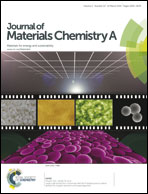Synthesis and characteristics of novel layered silicate HUS-7 using benzyltrimethylammonium hydroxide and its unique and selective phenol adsorption behavior†
Abstract
A new layered silicate, HUS-7, was synthesized using amorphous silica, sodium hydroxide, biphenyl, and benzyltrimethylammonium hydroxide as a structure-directing agent (SDA). Structural analyses by powder X-ray diffractometry and solid-state magic-angle-spinning (MAS) NMR spectroscopy revealed that HUS-7 had a layered structure, which was composed of four-, five-, and six-membered rings. Its framework topology was partially similar to that of a HEU-type zeolite including the bre (10T)-type composite building unit. Structural refinement by the Rietveld method showed that the benzyltrimethylammonium cations used as the SDAs were incorporated into the interlayers. The presence of hydrogen bonding between adjacent terminal O atoms was clearly revealed by 1H MAS NMR spectroscopy and the electron-density distribution obtained by the maximum entropy method. HUS-7 selectively and effectively adsorbed phenol from acetonitrile solution containing benzene and phenol. The adsorption of phenol occurred through the exchange of water molecules in the interlayers with phenol.


 Please wait while we load your content...
Please wait while we load your content...